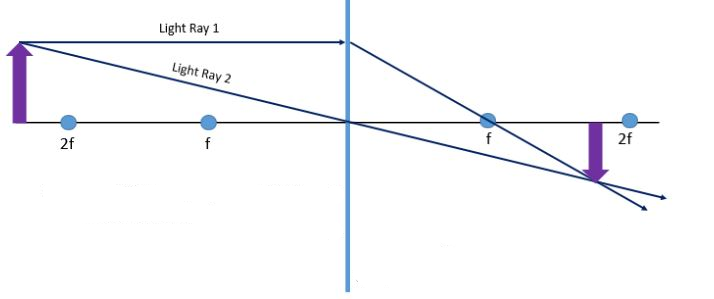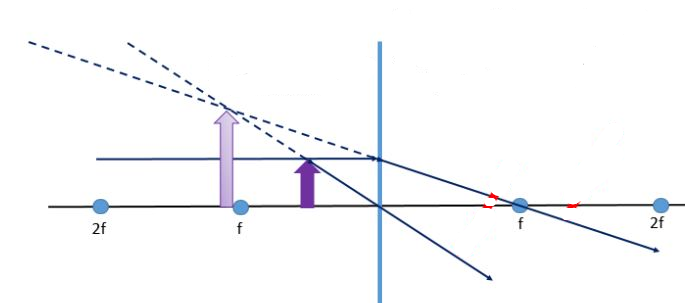
All Solutions
Page 582: Review
Real image is produced by the objective lens when the actual object is placed withing the focal length of the lens and virtual one is produced by the eyepiece lens which magnifies the real image which as a result gives large, virtual image of the actual objects.
The image of the candle placed at a distance of 34 centimeters in front of the lens will be real in nature and inverted in attitude. It will be identical in size as the candle because it is placed on $34=2(17)=2$F of the lens. The image will be formed at a distance of 34 centimeters from the lens on the other side of the lens as the object.
The image of the candle placed at a distance of 52 centimeters in front of the lens will be real in nature and inverted in attitude. It will be smaller in size as the candle because it is placed on $52>2(17)=2$F of the lens. The image will be formed at a distance less than 2F from the lens on the other side of the lens as the object.
The image of the candle placed at a distance of 17 centimeters in front of the lens will be real in nature and inverted in attitude. It will be infinitely huge in size as the candle because it is placed on the focus of the lens. The image will be formed at an infinite distance from the lens and therefore invisible to the human eye.
The image of the candle placed at a distance of 25 centimeters in front of the lens will be real in nature and inverted in attitude. It will be larger in size as the candle because it is placed on $25<2(17)=2$F of the lens. The image will be formed at a distance greater than 2F from the lens on the other side of the lens as the object.
The image of the candle placed at a distance of 12 centimeters in front of the lens will be virtual in nature and upright in attitude. It will be larger in size as the candle because it is placed on $12<17$, that is within the focal length of the lens. The image will be formed on the same side of the lens as the object.
Beam of light which is striking surface of the lens on the left side will diverge from the right side, appearing to diverge from the left focus and vice versa.
Reflected rays never focus into one single point there the image will be formed, their extensions do instead which makes formed image virtual.
$textit{b.}$, Image formed by diverging lens is virtual, therefore, upright in altitude.
$textit{b}$, Virtual: upright in altitude.


This condition is caused by the shortening of the eyeball which brings the retina closer to the lens which will cause formation of the real image behind the retina, as the result part of the image which falls on the retina will be blurred.
$textit{Presbyopia}$ is a form of farsightedness which is caused by the weakening of the eye muscles as they age.
That is why it is almost inevitable in old age.
Presbyopia is a form of farsightedness which is caused by the weakening of the eye muscles as they age.
$textit{Glaucoma}$ is an eye disorder which is caused by the damage of the optical nerve.
$textit{Cataracts}$ is an eye condition which leads to blurry vision since there is a “curtain” over the natural eye lens.
Glaucoma is an eye disorder which is caused by the damage of the optical nerve.
Cataracts is an eye condition which leads to blurry vision since there is a “curtain” over the natural eye lens.
$$
f=21
$$
$$
d_o=57
$$
Formula:
$$
dfrac{1}{d_0}+dfrac{1}{d_i}=dfrac{1}{f}
$$
Rearrange to solve for $d_i$:
$$
dfrac{1}{d_i}=dfrac{1}{f}-dfrac{1}{d_0}
$$
Simplify using least common denominator:
$$
dfrac{1}{d_i}=dfrac{d_0-f}{fd_0}
$$
Rearrange:
$$
d_i=dfrac{fd_0}{d_0-f}
$$
Substitute values:
$$
d_i=dfrac{21(57)}{57-21}
$$
Simplify and evaluate:
$$
d_i=dfrac{1197}{36}=dfrac{133}{4}=33.25
$$
The image of the object (candle) formed is $33.25$ cm away from the lens.
The positive value of $d_i$ indicates that this image is real in nature and inverted in attitude. Also note that it is formed on the other side of the lens as the object.
$$
f=18
$$
$$
d_o=13
$$
$$
dfrac{1}{d_0}+dfrac{1}{d_i}=dfrac{1}{f}
$$
Rearrange to solve for $d_i$:
$$
dfrac{1}{d_i}=dfrac{1}{f}-dfrac{1}{d_0}
$$
Simplify using least common denominator:
$$
dfrac{1}{d_i}=dfrac{d_0-f}{fd_0}
$$
Rearrange:
$$
d_i=dfrac{fd_0}{d_0-f}
$$
Substitute values:
$$
d_i=dfrac{18(13)}{13-18}
$$
Simplify and evaluate:
$$
d_i=dfrac{234}{-5}=-46.8
$$
The image of the object (leaf) formed is $46.8$ cm away from the lens.
$$
h_o=14
$$
$$
h_i=43
$$
$$
M=dfrac{h_i}{h_o}
$$
Substitute values:
$$
M=dfrac{43}{14}
$$
Evaluate:
$$
M=3.071
$$
The magnification of the lens is $3.071$
$$
h_o=18
$$
$$
h_i=12
$$
Equation of magnification in terms of height:
$$
M=dfrac{h_i}{h_o}
$$
Substitute values:
$$
M=dfrac{12}{18}
$$
Evaluate:
$$
M=0.bar6
$$
The magnification of the lens is $0.bar6$
$$
d_i=11
$$
$$
d_o=53
$$
$$
dfrac{1}{f}=dfrac{1}{d_0}+dfrac{1}{d_i}
$$
Substitute values:
$$
dfrac{1}{f}=dfrac{1}{53}+dfrac{1}{11}
$$
Simplify:
$$
dfrac{1}{f}=0.0189+0.bar0bar9=0.1098
$$
Evaluate:
$$
f=dfrac{1}{0.1098}=9.107
$$
The focal length of the camera lens is $9.107$ centimeters.
b. The image is on the same side of the lens as the object.
$textit{b.}$, Student’s eyeglasses have lenses that have negative meniscus which are modified version of diverging ones, since they focus light rays in the retina which helps people with farsightedness see clearer.
$textit{b.}$, His eyeglasses have negative meniscus.
In both cases screen is fixed which helps lens in a formation sharp image.
In the case of human eye focusing is done by the eye muscles which are slightly changing shape of the lens and in the case of camera focusing is done manually.
In the case of camera images are formed on a photographic film and in the case of human eye images are formed on the retina.
Focusing is done by the eye muscles in the case of human eye and manually in the case of camera and images are formed in the retina in the case of human eye and on the photographic film in the case of the camera.
People with eye conditions will not be able to see well, we will not be able to use devices which are important for scientific research such as microscope, telescope etc.
We will not be able to take photos, since the cameras are useful without lenses, flashlights will be useless as well.
Lasers, which are important nowdays, could not be controlled.
In ancient times, people knew hot to enlarge things by using glass spheres filled with water.
In Venice, people knew how to shape glass in convex shapes which they were holding in one hand while reading, but after, when they were making discs out of glass which they were using to close jars etc., they discover that while looking through the discs they can see objects more clearly.
This is the time when lenses made of glass, for reading, were massive produced.
First eyeglasses were made of round lenses which were biconvex and farsightedness has been improved.
These two lenses were assembled with rim of metal or wrapped in leather and were being held with one handle.
Around 1400., printed has been invented, therefore, the books became more available which has raised request for the eyeglasses.
Then, they made better steadiness for glasses on the nose, for the people who had to use both hands while working.
There was a development in the processing of metal frames.
New ways to secure eyeglasses firmly have been discovered: to tie lenses around the head or bar under the hat etc.
Edward Scarlett has perfected glasses which were now equipped with side-arms.
Then, the bifocals were invented which are lenses with two different optical powers which made each lens separated in two parts from which one has been treating farsightedness and one has been treating nearsightedness.
Then, the most popular were eyeglasses without side-arms.
They became a famous fashion accessory which have protected eyes and was irreplaceable for the vision.
Nowdays, new materials are combined with different designs and Italian eyewear is world leader when it comes to eyeglasses.
They consist intensifier tubes which use reflected infrared radiation which is invisible to the human eye. This radiation is is emitted by the Sun and stars.
These devices have:
– intensifier tubes and these contains tubes which have photocathode at one end and internal anode in the very middle and on the other end is the phosphor screen.
There is a high voltage between photocathode and anode and it creates a strong electrostatic field.

There are three types of 3D glasses:
1. anaglyph
2. polarized
3. shutter
Anaglyph glasses use special lenses in variations of red/blue colours (red/cyan, red/green, magenta/green).
Image that we actually see is produced by filtering of the colour of the layered image we are looking at. One lens filters out all the red, and the other one filters out blue which is causing our brain to see in 3D and the image we are looking at is one same image which is projected from two different angles or two entirely different images.
Image which is projected on the screen is two, superimposed images, through an orthogonal polarizing filter and glasses have exactly the same filter which allows each eye to see two different images.
They are mostly battery powered and are pretty expensive.
It relies on the distance between our eyes in order to present us with two different perspectives of the same thing. Work of 3D glasses depends on how eyes work and communicate with our brain.
“If you want to get fully experience while watching your favourite movie and to explore wonders of Sci-Fi world hand by hand with your favourite heroes or just enjoy beautiful landscapes, put on your 3D glasses, sit relax and enjoy your favourite movie, or participate in it just by watching it!”
Chromatic aberration is a lens defect in which the colors of the white light become dispersed on refraction through it. This happens because each wavelenght of light refracts at a slightly different angle than the rest. The images formed by these defected lenses is over-exposed with color fringes and one color is more prominent than the rest. This defect can be reduced by using an achromatic lens in combination with this lens.
Spherical aberration is a lens defect in which each refracted ray of light refracts at a slightly different angle than the rest and instead of converging to the focus of the lens, they intersect the principal axis at different points. This defect can be reduced by using a refractive diffractive lens in combination with the defected lens.
This happens because each colour has different wavelength, therefore it has different changes in speed which cause bending at different angle.
Images which are formed by defected lenses are over-exposed with colour fringes and one colour is more prominent than the rest.
This defect is being reduced by an achromatic lens which is combined with the defected lens.
$textit{b.}$, Spherical aberration is defect of the lens in which each refracted ray of light refracts at a slightly different angle and instead of converging to the focus of the lens, rays intersect the principal axis at very different points.
This defect is being reduced by a refractive diffractive lens which is being combined with the defected lens.
$textit{b.}$, Spherical aberration is defect of the lens in which each refracted ray of light refracts at slightly different angle and instead of converging to the focus, rays intersect the principal axis at different points.
hline
& optician & optometrist & opthalmologist \ hline
skill exhibits & begin{tabular}[c]{@{}l@{}}measuring, fitting \ and adjusting glassesend{tabular} & begin{tabular}[c]{@{}l@{}}providing primary vision\ care ranging (sight testing, treatment)end{tabular} & correcting eye conditions \ hline
career & customer service specialists & eye care specialist & begin{tabular}[c]{@{}l@{}}medical doctors,\ specialized in surgery of\ the eyeend{tabular} \ hline
end{tabular}

